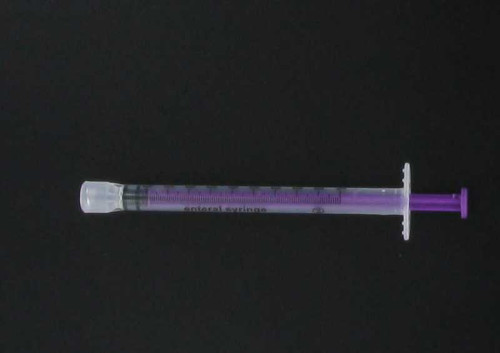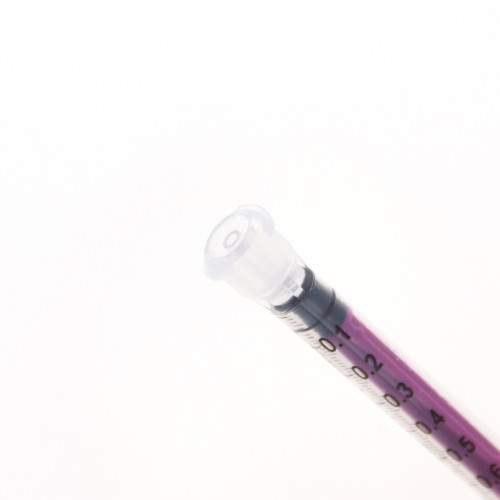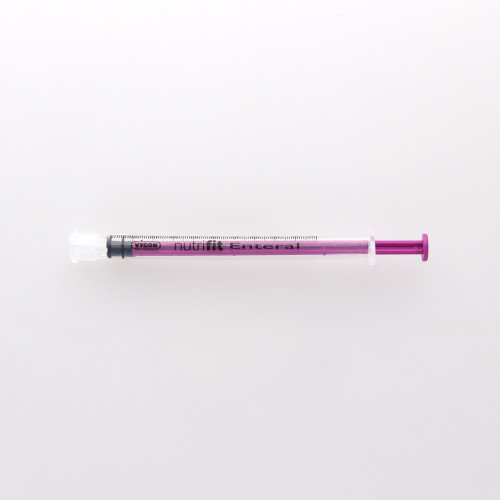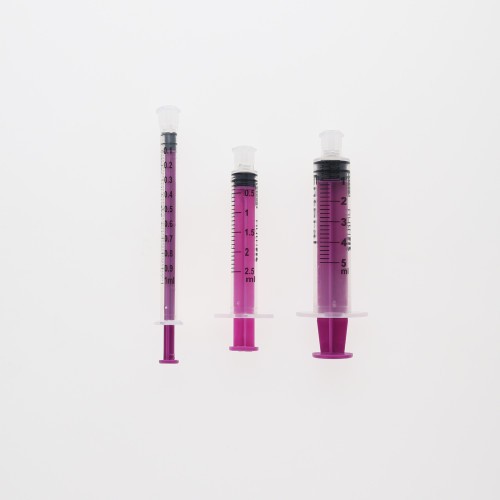Syringes
"Low dose tip" syringes
Description
“ENFit Low dose Tip” syringes for enteral nutrition, which connect with ENFit feeding tubes or with any device featuring a male ENFit… Read more
Indication
Enteral nutrition
Description
“ENFit Low dose Tip” syringes for enteral nutrition, which connect with ENFit feeding tubes or with any device featuring a male ENFit connection.3 volumes are available: 1ml, 2.5ml and 5ml.
Each syringe is fitted with a purple-coloured plunger, enabling instant identification for enteral use.
The “ENFit Low dose Tip” connection is centered.
The graduation is every 0.01ml for the 1ml syringe (code 1015.018), every 0.1ml for the 2.5ml syringe (code 1015.028) and every 0.2ml for the 5ml syringe (code 1015.058).
For reminder, the “Nutrifit” brand of Vygon specifies products, which are fitted with an ENFit connection compliant with the ISO 80369-3 standard. Consequently, accidental misconnections between devices intended for enteral nutrition and devices intended for other clinical applications (venous access, spinal, epidural, vesical, respiratory…) are mitigated and the right administration route is respected.
References and Features
| Syringe | Packaging | ||||
|---|---|---|---|---|---|
| Favourites | Code | Volume ml | Graduation (every) ml | Units/Box | Units/Case |
| 1015.018 | 1 | 0.01 | 100 | 2400 | |
| 1015.028 | 2.5 | 0.1 | 100 | 2000 | |
| 1015.058 | 5 | 0.2 | 100 | 1600 | |
Additional information
-
Contains Latex No
-
Contains animal product No
-
Pyrogen-free No
Documentation
-
Enteral nutrition catalogue
-
Instructions for use
FAQ
Codes 1015.018 / 1015.028 / 1015.058: Can Nutrifit syringes be frozen?
Nutrifit syringes have not been tested when freezing. The minimum tested is 4°C. At -25°C, the material may break and, obviously, the performance of the rubber gasket may be compromised.
Code 1015.018: What is the dead space of the syringe?
When the moat is completely clear of fluid, the dead space is 0.134ml. Calculation following the ISO 7886-1:1997 Section 14.1 and Annex C (and Solidworks theoretical measurement for the LDT syringes’ full moat). However, it is important to differentiate the dead space from the volume displacement. The dead space is the residual fluid, which remains in the syringe after administration. The volume displacement is the additional fluid, which is administrated additionally to the prescribed dose due to the manipulations. The volume displacement of the LDT syringe is around 0ml if the LDT syringe is used properly (no fluid in the moat). The volume displacement of the LDT syringe is 0.120ml in average if the LDT syringe is not used correctly (presence of fluid in the moat). Calculation done by CFD simulation by the independent company ANDHEO.
Code 1015.028: What is the dead space of the syringe?
When the moat is completely clear of fluid, the dead space is 0.136ml. Calculation following the ISO 7886-1:1997 Section 14.1 and Annex C (and Solidworks theoretical measurement for the LDT syringes’ full moat). However, it is important to differentiate the dead space from the volume displacement. The dead space is the residual fluid, which remains in the syringe after administration. The volume displacement is the additional fluid, which is administrated additionally to the prescribed dose due to the manipulations. The volume displacement of the LDT syringe is around 0ml if the LDT syringe is used properly (no fluid in the moat). The volume displacement of the LDT syringe is 0.120ml in average if the LDT syringe is not used correctly (presence of fluid in the moat). Calculation done by CFD simulation by the independent company ANDHEO.
Code 1015.058: What is the dead space of the syringe?
When the moat is completely clear of fluid, the dead space is 0.138ml. Calculation following the ISO 7886-1:1997 Section 14.1 and Annex C (and Solidworks theoretical measurement for the LDT syringes’ full moat). However, it is important to differentiate the dead space from the volume displacement. The dead space is the residual fluid, which remains in the syringe after administration. The volume displacement is the additional fluid, which is administrated additionally to the prescribed dose due to the manipulations. The volume displacement of the LDT syringe is 0ml if the LDT syringe is used properly (no fluid in the moat). The volume displacement of the LDT syringe is 0.120ml in average if the LDT syringe is not used correctly (presence of fluid in the moat). Calculation done by CFD simulation by the independent company ANDHEO.





